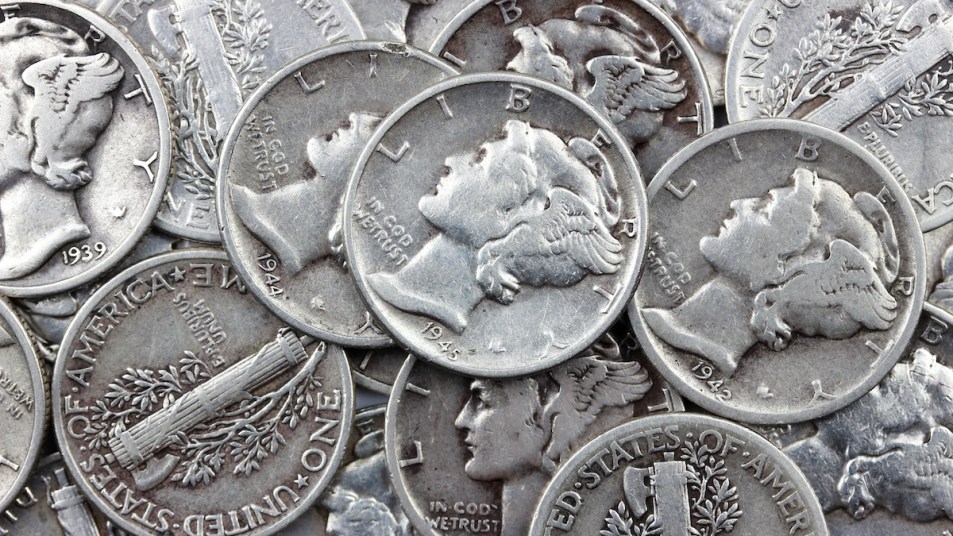Got a 1943 Mercury Dime? It Could Be Worth Hundreds of Dollars
Keep your eye out for this lady with a winged headpiece.

Most of us tend to overlook spare change, letting it sit for years in jars or jingle aimlessly in our purses — but on rare occasions, treasures can be found. From the 1974 silver dollar coin to the Wisconsin quarter, there are a variety of high-value coins that are worth sorting through your stash to find. If you have a 1943 Mercury dime, it could be worth hundreds (or even, in rare cases, thousands). Read on to learn about what makes the Mercury Dime so special, and determine whether you could be sitting on a chunk of change that far exceeds 10 cents.
What’s the history of the 1943 Mercury Dime?
You already know what a dime is — but what, exactly, is a Mercury dime? These popular collectible dimes, which are 90 percent silver and 10 percent copper, were produced by the US Mint for 29 years, from 1916 to 1945. Designed by Adolph A. Weinman, these dimes feature a woman’s head crowned with wings which he described as “symboliz[ing] liberty of thought,” in a letter sent to The Numismatist. The reverse side of the coin features an olive branch to “symbolize the strength which lies in unity,” along with a battle axe that represents “preparedness to defend the Union.”
This coin is sometimes referred to as the Liberty Head Dime, but it’s typically called the Mercury Dime because the woman depicted on it, who symbolizes Liberty, was thought to more closely resemble the Roman God Mercury due to her winged headpiece. The design was well-liked, but had to be modified because it “did not get along with vending machines,” reports JM Bullion, a shop specializing in coins and metals. In 1945, production of the Mercury Dime ceased, and it was replaced with a new design featuring the recently deceased President Franklin Roosevelt.
There are a few different varieties of this dime, all of which look the same. The main difference is their mint mark, which indicates where the coin was produced. Here are the varieties to look out for, listed from most to least common.
- 1943 Coins: These coins were produced in Philadelphia, and are the most common. Approximately 191,710,000 of these coins were minted.
- 1943 D Coins: These coins were produced in Denver. Approximately 71,949,000 of these coins were minted.
- 1943 S Coins: These coins were produced in San Francisco, and are the least common. Approximately 60,400,000 of these coins were minted.
While the standard 1943 Mercury Dime is less valuable than the D or S variety, you might still be able to get a few hundred dollars if it’s in pristine, uncirculated condition — and the D and S coins could be worth even more.
What are the common errors on 1943 Mercury Dimes?
According to Ned Ludd Coins, the 1943 Mercury Dime was not produced with many errors. Errors can often add value to coins, because they make them more unique. Two errors to look out for include the Broad-Struck Error, an error which occurs when a coin “is minted without the use of a collar, which is a retaining ring used to determine the final diameter of the coin being minted,” and the Repunched Mint Mark Error, in which “the letter punch used to punch the mintmark onto the working die makes two or more imprints.” If your dime has either of these errors, its value may increase. To learn more, check out this video from Couch Collectibles.
What’s the value of a 1943 Mercury Dime?
Ned Ludd Coins points out that 1943 Mercury Dimes were very widely circulated, with well over 300 million of them minted at the time. That said, if you have one of these coins in pristine condition, it can sell for up to $425, says NGC Coin Explorer. In 2010, a 1943 Mercury Dime sold at auction for $19,550, a record high. This particular coin sold for such a high amount due to its full bands (a specific phrase referring to the rare shape and texture of a design element on the coin’s back) and its “gleaming silver surfaces show[ing] faint golden-tan peripheral toning.” Heritage Auctions described this high-value coin as a “strongly struck and shining beauty,” which sounds pretty appealing.
You’re unlikely to get $19,550 for a 1943 Mercury Dime (though, who knows, maybe you’ll get lucky!). However, if your coin features one of the Broad-Struck or Repunched Mint Mark errors discussed above, it could be worth $100 or more. (By contrast, if your dime is in used, regular condition, it’s only likely to net you a few dollars.) On eBay, a 1943 Mercury S Dime in superb, uncirculated condition is currently asking for $3,999.99. Littleton Coin Company is selling a D variety of 1943 Mercury Dime for $275.
To get a better idea of the varieties of 1943 Mercury Dimes and how much your coin might be worth, check out this extensive list of past auction prices from Professional Coin Grading Services.
While this dime is by no means the rarest type of coin out there, it’s a visually dynamic piece of currency that might bring in a nice chunk of change should it sport a rare error or be in its purest form. So, next time you go through your change jar, make sure to see if any of your dimes sport a lady with a winged headpiece.
Learn about more valuable currency here:
How Much Are Two Dollar Bills Worth? Discover If Your Rare Bill Is Worth Big Bucks
Spotting This Rare Nickel Will Earn You a Ton of Cash
A 1979 One Dollar Coin Sold for Over $15,000 — Here’s How To Tell if Yours Is Valuable












